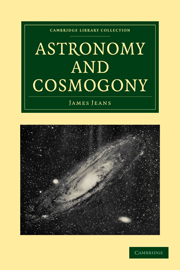Book contents
- Frontmatter
- Contents
- LIST OF ILLUSTRATIONS
- PREFACE
- CHAP. I The Astronomical Survey of the Universe
- CHAP. II The Light from the Stars
- CHAP. III Gaseous Stars
- CHAP. IV The Source of Stellar Energy
- CHAP. V Liquid Stars
- CHAP. VI The Evolution of the Stars
- CHAP. VII Non-spherical Masses–Dynamical Principles
- CHAP. VIII The Configurations of Rotating Liquid Masses
- CHAP. IX The Configurations of Rotating Compressible Masses
- CHAP. X Rotation and Fission of Stars
- CHAP. XI The Evolution of Binary Systems
- CHAP. XII The Ages of the Stars
- CHAP. XIII The Great Nebulae
- CHAP. XIV The Galactic System of Stars
- CHAP. XV Variable Stars
- CHAP. XVI The Solar System
- CHAP. XVII Conclusion
- Index of Subjects
- Index of Names
CHAP. I - The Astronomical Survey of the Universe
Published online by Cambridge University Press: 07 September 2010
- Frontmatter
- Contents
- LIST OF ILLUSTRATIONS
- PREFACE
- CHAP. I The Astronomical Survey of the Universe
- CHAP. II The Light from the Stars
- CHAP. III Gaseous Stars
- CHAP. IV The Source of Stellar Energy
- CHAP. V Liquid Stars
- CHAP. VI The Evolution of the Stars
- CHAP. VII Non-spherical Masses–Dynamical Principles
- CHAP. VIII The Configurations of Rotating Liquid Masses
- CHAP. IX The Configurations of Rotating Compressible Masses
- CHAP. X Rotation and Fission of Stars
- CHAP. XI The Evolution of Binary Systems
- CHAP. XII The Ages of the Stars
- CHAP. XIII The Great Nebulae
- CHAP. XIV The Galactic System of Stars
- CHAP. XV Variable Stars
- CHAP. XVI The Solar System
- CHAP. XVII Conclusion
- Index of Subjects
- Index of Names
Summary
The moon, our nearest neighbour in the sky, is 240, 000 mites away from us; a distance which light, travelling at 186, 000 miles a second, traverses in a little over one second. The farthest astronomical objects whose distances are known are so remote that their light takes over one hundred million years to reach us. The ratio of these two periods of time–a hundred million years to a second–is the ratio of the greatest to the least distance with which the astronomer has to deal, and within this range of distances lie all the objects of his study.
As he wanders through this vast range with the aid of his telescope, he finds that the great majority of the objects he encounters fall into well-defined classes; they may almost be said to be “manufactured articles” in the sense in which Clerk Maxwell applied the phrase to atoms. Just as atoms of hydrogen or of oxygen are believed to be of similar structure and properties wherever they occur in nature, so the various astronomical objects–common stars, binary stars, variable stars, star-clusters, spiral nebulae, etc.–are believed to be, to a large extent at least, similar structures no matter whore they occur.
The similarity, it is true, is not so definite or precise as that between the atoms of chemistry, and perhaps a better comparison is provided by the different species of vegetation which inhabit a country.
- Type
- Chapter
- Information
- Astronomy and Cosmogony , pp. 1 - 29Publisher: Cambridge University PressPrint publication year: 2009First published in: 1928



